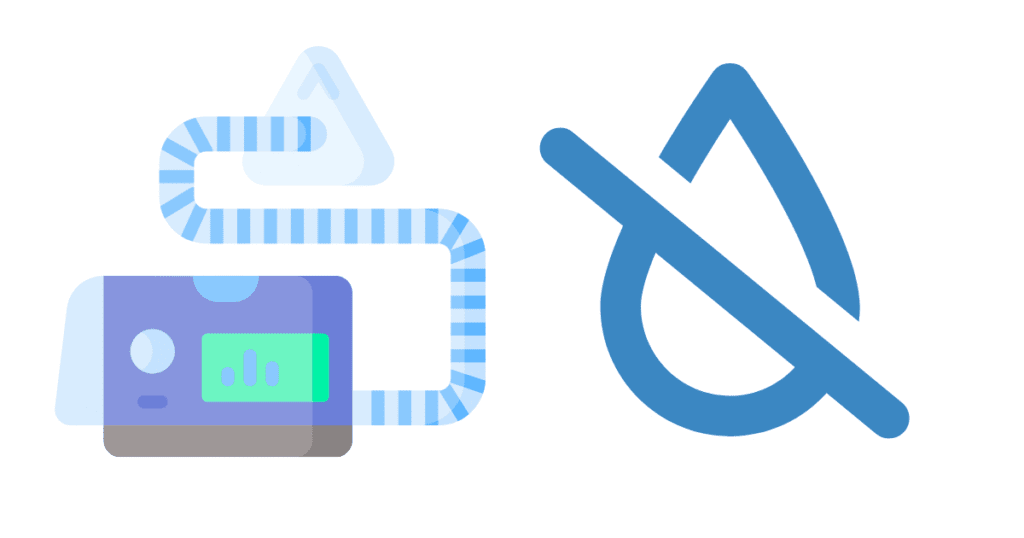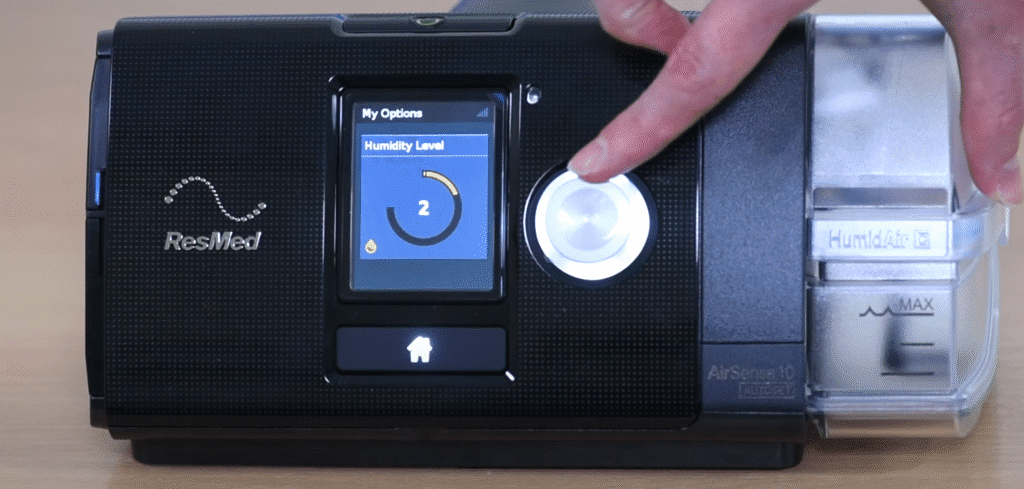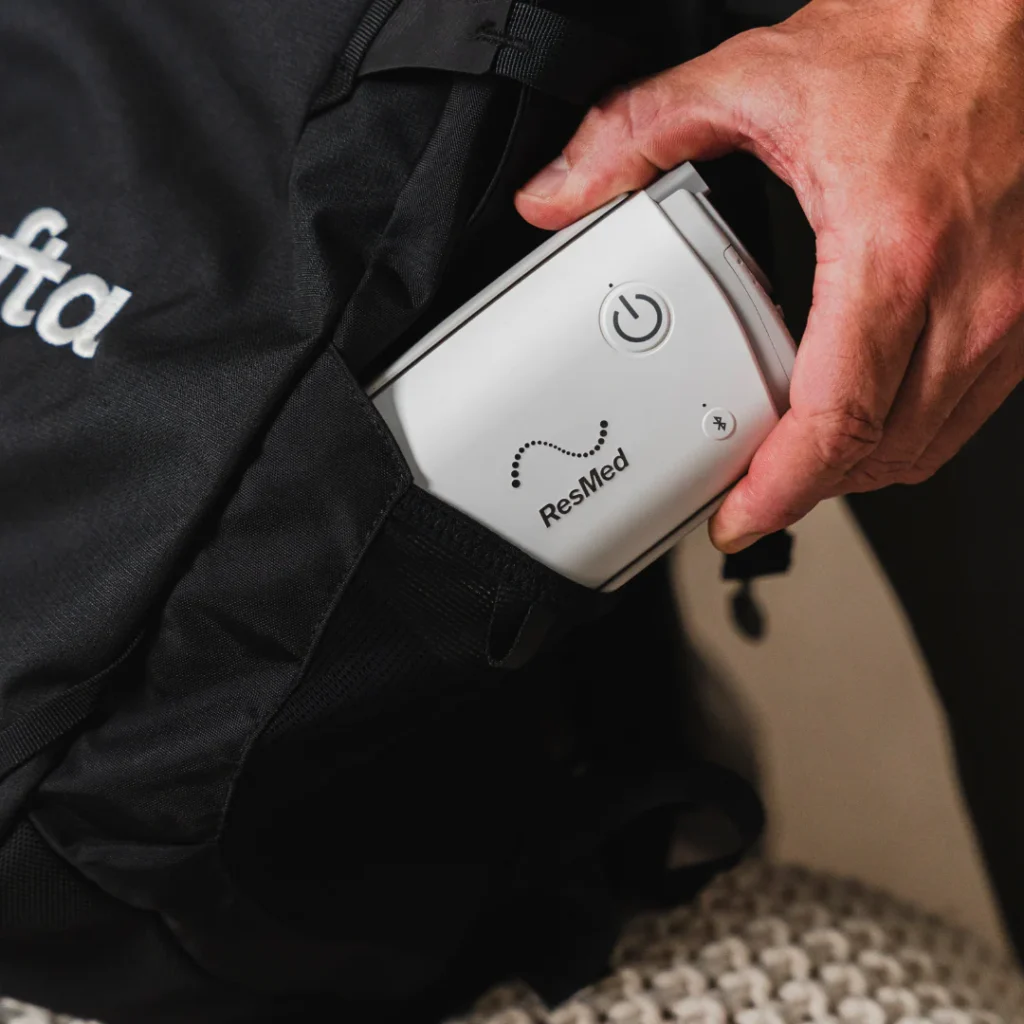Can You Use CPAP Without Water? What You Need to Know
If you’re dealing with CPAP rainout, tired of daily water changes, or planning to travel with your machine, you might be wondering if you really need that water chamber.
The good news is that waterless CPAP therapy is not only possible – it can offer some real advantages over traditional humidified setups. Of course, it’s not perfect for everyone, so let’s explore when dry CPAP works best and when you might want to stick with humidification.

Disclosure: This article is reader-supported and contains affiliate links.
The Basics of Waterless CPAP
Continuous Positive Airway Pressure (CPAP) therapy is the gold standard for treating sleep apnea. Traditionally, CPAP machines use a water chamber to humidify the air, making it more comfortable to breathe.
However, waterless or “dry” CPAP therapy eliminates this humidification step.
Dry CPAP works the same way as its humidified counterpart – it delivers a constant stream of pressurized air to keep your airways open during sleep. The key difference is that the air isn’t moistened before it reaches your nose or mouth.
Advantages of Going Waterless
Simplified Maintenance
One of the biggest perks of waterless CPAP is the reduced maintenance. No more daily water changes or weekly deep cleans of the humidifier chamber.
This can be a real time-saver, especially for busy people or frequent travelers.
With a dry setup, you’ll only need to focus on cleaning your mask, tubing, and machine’s exterior. This simplified routine can make it easier to stay consistent with your CPAP therapy, which is crucial for effective treatment.
Improved Portability
Without the need for distilled water or a bulky humidifier, dry CPAP setups are often lighter and more compact. This makes them ideal for camping trips, business travel, or any situation where space and weight are at a premium.
Many waterless CPAP machines are designed with travel in mind.
They’re smaller, lighter, and some even come with built-in batteries for use in places without reliable electricity.
This portability can be a game-changer for people who travel often or enjoy outdoor activities.
See our top recommendation for travel here.
Reduced Risk of “Rainout”
“Rainout” occurs when water condenses in the CPAP tubing, leading to gurgling noises and sometimes even water in your mask. By eliminating water altogether, dry CPAP completely sidesteps this issue.
Rainout can be more than just annoying – it can disrupt your sleep and potentially lead to mask leaks or pressure changes. Eliminating this risk can lead to more consistent, comfortable therapy.
Lower Risk of Bacterial Growth
Standing water in CPAP humidifiers can potentially become a breeding ground for bacteria if not cleaned properly. Waterless setups eliminate this risk entirely.
While proper cleaning and maintenance of humidified systems can mitigate this risk, dry CPAP provides extra peace of mind. This can be particularly useful for people with compromised immune systems or those who struggle to keep up with rigorous cleaning routines.
Potential Drawbacks to Consider
Increased Nasal Dryness
The most common complaint about dry CPAP is increased nasal dryness or irritation. Some users find that the lack of humidification leads to a stuffy or congested feeling, especially in the morning.
This dryness can sometimes lead to nosebleeds or sinus discomfort. However, many users find that their bodies adjust to the drier air over time, and there are strategies to help mitigate this issue (which we’ll cover later in this article).
Possible Compliance Issues
For some patients, the discomfort associated with dry air can make it harder to stick with their CPAP therapy long-term. This is a serious consideration, as consistent use is crucial for effective treatment.
If you’re struggling with dryness or irritation, it’s important to communicate with your sleep specialist. They can help you find solutions or decide if a humidified system might be a better fit for your needs.
Climate Considerations
In very dry climates or during winter months when indoor heating reduces humidity levels, waterless CPAP may be less comfortable. You might find yourself needing to adjust your approach seasonally.
Some users find that they can use dry CPAP comfortably for most of the year but switch to a humidified system during the driest months. This flexibility can help you maintain consistent therapy year-round.
Adapting to Waterless CPAP: Tips and Tricks
If you’re interested in trying dry CPAP but worried about potential discomfort, here are some strategies that have worked for me and other users:
1. Gradual Transition

Start by reducing the humidity level on your current setup gradually over a few weeks. This can help your body adjust more easily to the drier air.
Begin by lowering your humidity setting by one level every few days. Pay attention to how you feel each morning and adjust accordingly.
This slow transition can help minimize discomfort and increase your chances of success with waterless CPAP.
2. Nasal Saline Spray
Using a saline nasal spray before bed can help moisturize your nasal passages naturally. Look for a preservative-free option to avoid potential irritation.
Some users find it helpful to use saline spray both before bed and upon waking. This can help combat dryness and congestion associated with dry CPAP therapy.
3. Room Humidifier
Consider using a separate room humidifier to add moisture to the air in your bedroom. This can help create a more comfortable environment overall, not just for your CPAP therapy.
Be sure to clean your room humidifier regularly to prevent mold and bacteria growth. Also, avoid placing it too close to your CPAP machine to prevent any interference with the air pressure.
4. Heated Tubing
Some CPAP machines offer heated tubing options, which can help prevent condensation and make the air feel less dry, even without water. This CPAP machine with heated tubing provides the perfect balance for users who want dry therapy with added comfort
Heated tubing works by maintaining a consistent temperature throughout the length of the tube. This can help reduce the feeling of cool, dry air and make your therapy more comfortable.
5. Proper Mask Fit
Ensure your mask fits well to minimize air leaks, which can exacerbate dryness. A well-fitting mask can also help reduce the amount of air needed to maintain proper pressure, potentially decreasing dryness.
Take the time to adjust your mask straps properly each night. If you’re consistently experiencing leaks, it might be time to try a different mask style or size.
When Waterless CPAP Might Be Your Best Option
Dry CPAP can be particularly useful in certain situations:
Frequent Travelers
If you travel often, the portability of a waterless system can be very helpful. You won’t need to worry about packing distilled water or dealing with TSA regulations regarding liquids.
Many travel-friendly CPAP machines are designed for waterless use, making them compact and lightweight. This can make a big difference when you’re trying to pack light or navigate through airports.
Humid Climate Dwellers
If you live in a humid climate where rainout is a constant issue, dry CPAP can eliminate this problem entirely. You’ll no longer have to worry about waking up to a wet mask or gurgling noises in your tubing.
In very humid environments, the natural moisture in the air can often provide enough humidity for comfortable breathing, making a humidifier unnecessary.
Those Prone to Bacterial Growth Issues
If you’ve experienced problems with bacterial growth in your humidifier, switching to a waterless system can provide peace of mind. This can be especially important for people with respiratory sensitivities or compromised immune systems.
While proper cleaning can prevent bacterial growth in humidified systems, a dry setup eliminates this concern altogether.
Time-Strapped Individuals
If you find the maintenance of a water chamber too time-consuming, a waterless system can simplify your routine. This can be particularly useful for people with busy schedules or those who struggle with the daily upkeep of their CPAP equipment.
With a dry system, you’ll only need to focus on cleaning your mask and tubing, which can significantly reduce your daily CPAP maintenance time.
When to Stick with Humidification
On the flip side, you might want to keep using a humidifier if:
You Live in a Very Dry Climate
In arid environments, the added moisture from a humidifier can make a significant difference in comfort. If you live in a desert climate or an area with very low humidity, a humidified system might be necessary for comfortable therapy.
You Often Experience Nasal Congestion or Nosebleeds
If you’re prone to nasal issues, the added moisture from a humidifier can help keep your nasal passages healthy and comfortable. Humidified air can help reduce congestion and prevent the dryness that can lead to nosebleeds.
You Have a History of Upper Respiratory Infections
Humidified air can help maintain the natural defenses of your respiratory system. If you’re prone to sinus infections or other upper respiratory issues, the added moisture might be useful for your overall health.
You Find it Difficult to Follow CPAP Therapy Without Added Moisture
Ultimately, the most important factor is your comfort and ability to consistently use your CPAP. If you’ve tried waterless CPAP and found it too uncomfortable, sticking with a humidified system is the right choice.
The Future of Waterless CPAP
As CPAP technology continues to improve, we’re seeing more innovations aimed at improving the comfort of dry therapy. Some manufacturers are developing new mask materials that help keep natural moisture, while others are exploring choice humidification methods that don’t require water.
One exciting development is the use of heat moisture exchangers (HMEs) in CPAP masks. These devices capture the moisture from your exhaled breath and use it to humidify the incoming air, providing a level of humidification without the need for water.
Another area of innovation is in smart CPAP technology. Some newer machines can adjust pressure and other settings based on your breathing patterns and environmental conditions, potentially making dry CPAP more comfortable for a wider range of users.
Exercises to Optimize Your CPAP Experience
Whether you choose to go waterless or stick with humidification, these exercises can help improve your overall CPAP experience:
1. Nasal Breathing Practice
Spend 5-10 minutes each day practicing breathing slowly and deeply through your nose. This can help strengthen your nasal passages and reduce mouth breathing during sleep.
Start by sitting comfortably and focusing on your breath. Inhale slowly through your nose, feeling the air move through your nasal passages.
Exhale gently, again through your nose.
As you practice, try to make your breaths longer and smoother.
2. Mask Fit Check
Once a week, put on your mask and run through a series of facial expressions – smile, frown, open your mouth wide. This can help you identify any potential leak points.
Pay attention to areas where you feel air escaping as you make these expressions. If you notice consistent leaks, it might be time to adjust your mask straps or your might want to try a different mask style.
3. CPAP Desensitization
If you’re new to CPAP or struggling with claustrophobia, try wearing your mask for short periods during the day while doing relaxing activities like reading or watching TV.
Start with just a few minutes at a time and gradually increase the duration. This can help you get used to the feeling of the mask without the pressure of needing to sleep.
4. Tongue and Throat Exercises
Strengthening the muscles in your tongue and throat can help reduce snoring and improve your CPAP therapy’s effectiveness. Try these exercises:
- Stick out your tongue and move it up, down, and side to side.
- Press your tongue against the roof of your mouth and slide it backward.
- Make a “tsk-tsk” sound by pressing your tongue against the roof of your mouth and then releasing it.
Perform each exercise 10 times, twice a day. Read more on sleep apnea exercises here.
5. Relaxation Techniques
Practice relaxation techniques before bed to help you fall asleep more easily with your CPAP mask on. Try progressive muscle relaxation or deep breathing exercises.
For progressive muscle relaxation, start by tensing and then relaxing each muscle group in your body, starting from your toes and working up to your head. This can help reduce physical tension and prepare your body for sleep.
Frequently Asked Questions
What is waterless CPAP therapy?
Waterless CPAP therapy, also known as dry CPAP, is a method of delivering continuous positive airway pressure without using a humidifier. The machine provides pressurized air directly to the user without adding moisture.
Can I use my CPAP machine without water?
Yes, many CPAP machines can be used without water. Some are specifically designed for waterless use, while others have removable humidifier chambers that can be left empty.
Is waterless CPAP as effective as humidified CPAP?
Waterless CPAP can be just as effective at treating sleep apnea as humidified CPAP. The main difference is in comfort, not effectiveness.
Some users find dry CPAP less comfortable, while others prefer it.
How do I prevent dry mouth with waterless CPAP?
To prevent dry mouth with waterless CPAP, try using a chin strap to keep your mouth closed, using a full-face mask instead of a nasal mask, or using a saline nasal spray before bed. Staying well-hydrated throughout the day can also help.
Can waterless CPAP cause nosebleeds?
While waterless CPAP can potentially cause nasal dryness that may lead to nosebleeds in some users, this isn’t common. If you experience nosebleeds, try using a saline nasal spray or ask with your doctor about other solutions.
Is waterless CPAP better for travel?
Many users find waterless CPAP more convenient for travel because it eliminates the need to pack distilled water and reduces the risk of spills. Travel CPAP machines are often designed for waterless use to maximize portability.
How often should I clean my waterless CPAP machine?
Even without a water chamber, you should still clean your CPAP mask, tubing, and machine exterior regularly. Most manufacturers recommend daily cleaning of the mask and weekly cleaning of the tubing and machine exterior.
Can I switch between humidified and waterless CPAP?
Yes, many users switch between humidified and waterless CPAP depending on their needs and circumstances. Some find they prefer humidification in dry winter months but are comfortable with dry CPAP the rest of the year.
Does waterless CPAP use less electricity?
Waterless CPAP may use slightly less electricity than humidified CPAP because it doesn’t need to power a heating element for the water. However, the difference is usually minimal.
Can waterless CPAP help with CPAP rainout?
Yes, one of the main advantages of waterless CPAP is that it completely eliminates the issue of rainout (water condensation in the tubing), which can be a common problem with humidified systems.
Key Takeaways
- Waterless CPAP offers benefits like simplified maintenance, improved portability, and reduced risk of bacterial growth.
- The main drawback is potential nasal dryness, which can be mitigated with strategies like using nasal saline spray or a room humidifier.
- Dry CPAP isn’t for everyone – consider your climate, personal comfort, and any existing respiratory issues when deciding.
- Gradual transition and proper mask fit are crucial for success with waterless CPAP.
- The choice between humidified and dry CPAP isn’t permanent – you can always switch back if one method isn’t working for you.
Related Reading
- Best Mouth Tape for Sleeping
- Best Nasal Dilators for Snoring
- CPAP Mask Liners for ResMed f30i and f20
- CPAP Hose Holders
- Best Wedge Pillows for Sleep Apnea
Health Disclaimer: The information in this article is for educational purposes only and is not medical advice. Do not change your CPAP settings, equipment, or therapy without guidance from a qualified healthcare professional. If you experience discomfort or symptoms, consult your doctor promptly.

